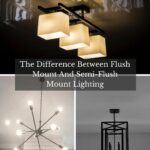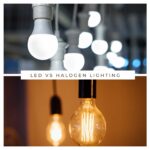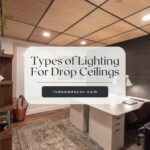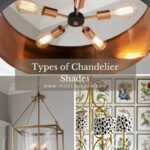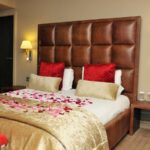In any space, proper lighting is essential. You need to fully illuminate the space while still providing the correct mood and function for the room. Of course, your lights must also match the existing architectural features of the space.
In modern day, a popular feature in both commercial and industrial spaces are drop ceilings.
These are easy to install, useful for large spaces and are great for a simple, professional feel. They also provide a great selection of lighting to choose from.
In more recent times, even some residential spaces are making use of drop ceilings. Used effectively, they can make for a really interesting, comfortable living space.
In this article, we’ll explore the topic of drop ceiling lighting. Namely, we’ll cover:
- What drop ceilings are.
- The many lights available for use with drop ceilings.
- How these lights can be used to achieve different effects.
- How they can be used in both industrial and residential spaces.
- The differences between LED and fluorescent lights for drop ceilings.
What Are Drop Ceilings?
In case you don’t already know, let’s quickly go over what a drop ceiling actually is.
Even if you don’t know the term, you’re sure to have come across a drop ceiling at some point.
We see them most often in offices, shops and industrial spaces like warehouses and factories. They’ve been a popular choice for these spaces since the 50s!
Drop ceilings are also known as suspended, t-bar and false ceilings.
There are a few forms they can take, but all drop ceilings involve a series of flat panels that hang below the “true” ceiling of the space.
They end up looking like a grid of panels that completely hide the real ceiling, making the room feel shorter overall.
Grid drop ceilings have a grid of long, metal strips that square or rectangular ceiling panels are slotted into. Drywall drop ceilings use wire to hang their panels instead.
Both types are used primarily to hide things like ductwork, pipes and electrical wiring while still allowing easy access for maintenance.
This is especially useful in commercial or industrial spaces where this access is needed regularly, like when changing the purpose of a room or updating equipment. It can get expensive tearing out a drywall ceiling every few months!
They are also quite a bit cheaper than traditional ceilings, especially in a very large space. This makes them appealing to companies constructing new buildings.
These features are also pretty handy in a residential home. This is especially true in refinished basements, since they often have a lot of wires, pipes and ductwork visible on the ceiling.
A drop ceiling allows the space to feel more finished and comfortable if converted to something like an office or home gym.
A final, less common use for drop ceilings is in homes with very high ceilings. This is often a problem in old, Victorian homes where ceilings can be 10ft high (or more!).
With very high ceilings like this, it can be hard to heat a home properly without spending a lot of money.
To fix this problem, the ceiling can be artificially “lowered” with a drop ceiling. Thus, a much smaller space can be heated easily.
Kelvin Light Temperature Value
Before we get started, you should also know about the temperature value of light.
This is used to describe how “warm” or “cold” the light is, which basically translates to how blue or red it looks.
This temperature is measured in Kelvins (K). A higher Kelvin value means a colder, whiter light. On the other hand, a lower value will produce a warmer, softer light.
There are a few reasons you should pay attention to this.
Most importantly, we perceive colder light as brighter– even if it doesn’t actually have a higher light output. This means that higher Kelvin lights will seem more vibrant and powerful.
High Kelvin lights are better for commercial or industrial spaces. Because the light seems brighter, it’s easier to see what you’re doing. They make the space feel professional, and help keep workers alert and focused.
On the other hand, a residential or otherwise “homely” space will benefit from lower Kelvin lights.
This is because a warmer light will make things feel more welcoming. The slightly dimmer feeling will also help us relax and feel safe and cozy in the environment, which is great for living rooms and bedrooms.
Usually, 2700 – 3300K is considered warm, whereas 3300 – 5300K is cool. Daylight has a kelvin value of 6500K.
Different Types of Ceiling Lights For Drop Ceilings
There are loads of lighting options for drop ceilings. They range from simple minimalism to crazy, eclectic traditionalism.
No matter what you want, you’ll probably find something that fits your style.
A lot of these lights are able to fit right into the grid of the drop ceiling. This makes for super easy ceiling installation and maintenance, hence their popularity.
The standard sizes for these easy-fit, drop ceiling specific lights are 1×4 ft, 2×2 ft and 2×4 ft. A bigger light will produce a wider beam of light, and illuminate a larger space.
Others aren’t specific to drop ceilings, but work very well with them.
The best light for drop ceilings in your space will depend heavily on the size of the room, its purpose and your personal style. Keep all of these things in mind as you read through our handy list of lights for drop ceilings!
1. Troffer Lights

These are one of the most popular lights used in commercial or industrial drop ceilings. They’ve been a staple of most offices, factories and warehouses since the mid 20th century!
You’ll most likely spot LED troffer lights in some other places as well, like hospitals, classrooms and stores.
This is because they are great at lighting up a large space with bright, white light that makes it easy to see what you’re doing.
Troffer lights are square or rectangular fixtures. In most cases, they fit into the drop ceiling the same as the other ceiling panels. However, in some cases, they can be fitted against the surface of the tiles instead.
They are normally quite bulky, so will stick out from the ceiling a bit. They often aren’t completely flush against the ceiling.
These lights really aren’t known for their aesthetics. Instead, they are a highly functional choice for commercial and industrial buildings. They provide bright, even light for a low cost.
In the past, troffer lights would have fluorescent bulbs inside. However, in the modern day, these have mostly been replaced by LED bulb lights. This is for several reasons– all of which we’ll cover in our LED vs fluorescent section!
2. Recessed Lights

These are similar to troffer lights, but are normally a completely flat panel that’s a lot thinner. This makes them a good choice for rooms that have less space above the drop ceiling!
Recessed lights match the size of the existing tiles in the drop ceiling, fitting into place like any other ceiling tile. They either drop straight into the metal grid or hang from wires alongside the other panels.
In some cases, something called a pattress is used. This is a set of plywood lengths that are made into a square slightly larger than a ceiling tile. They sit above the hole you want the light to go in, becoming a backing support for the light.
Pattresses are especially useful if the light is a lot heavier than a standard tile. Some grids or wires won’t be able to hold a heavy light fitting up without some help.
Using pattresses will greatly increase the number of light fittings you can use.
Generally, a brighter light will be a heavier one, since more intense hardware is needed to achieve the brighter illumination.
The best part of using recessed fluorescent lights is their small vertical size. They take up the minimum vertical real estate, which is perfect for low-ceiling spaces.
Normally, recessed lights are contained in a metal frame. In classic designs, they are made to be simple, out of the way, and unobtrusive.
However, in more modern designs they can have interesting finishes, colors or designs along their frames to bring more style to the room.
Some of these lights will have a diffuser placed over the lamp, which helps distribute the light and temper its intensity.
This diffuser can come in different materials that affect the output differently. For instance, a prismatic opal diffuser will create an extremely soft, gentle light that works great in a calm office space.
However, you should be aware that fluorescent recessed lights can cause eye strain and headaches in some people.
They also have a tendency to cause glare against things like computer screens, which can make them a poor choice in tech-heavy office spaces. This can be combated by using LED lights instead.
It should be noted that incandescent bulbs should not be used in drop ceilings.
These bulbs get too hot, and create a fire hazard when in close proximity to flammable ceiling panels. LED, halogen or fluorescent lights all work fine!
3. Canopy Lights

These lights are pretty similar to the troffer and recessed panel lights that we’ve already covered. Their biggest difference is their placement.
Canopy lights are used in outdoor spaces. Most often, they are placed inside overhangs, awnings and in the roof of covered patios or decks.
They are very common in places like parking garages, entrance ways, gas stations and along covered walkways. Normally, they are square or round, and can be fitted into the surface of the ceiling or fitted against it.
Most canopy lights are offered in a retrofit version as well.
They are designed to provide maximum brightness at night, being pointed at the area directly below them.
Canopy lights are made for the outdoors. This means they can survive temperature extremes and weather conditions for the most part. Many are also rated for dust and water protection.
Their main purpose is security and comfort in a dark space, letting people feel more secure while walking through the darkness. This is especially important in front of commercial buildings.
They also help to welcome customers towards the building as they arrive, creating a safer, more comfortable atmosphere.
To be as bright as possible, they normally use white light with a high Kelvin value.
4. Surface Mounted Lights

These lights aren’t limited to drop ceilings, since they attach directly to the surface of the original ceiling.
This means there is a very wide variety of lights available in this style that work fine on a drop ceiling, making them a good choice if you want something more stylish.
This category includes everything from track lights to chandelier and pendant lamps.
It should be noted that these lights don’t attach to the ceiling panels of the drop ceiling. Instead, they attach to the original ceiling of the building, above the drop ceiling.
The light is hung from a ceiling joist on this ceiling, then dropped through a hole in the suspended ceiling below. With a suitable small hole, the illusion of the light hanging from the drop ceiling can be created.
Hanging lights from the drop ceiling panels is a quick way to damage your grid or wires, and make a very big mess!
Because it hangs from a proper joist, the light can be pretty heavy before causing any issues. This means you can get very decorative with your lights– even hanging large chandeliers if you want.
5. LED Light Panels

These are one of the most popular modern lights used in drop ceilings.
These square or rectangular panels are another option that’s made to fit into the ceiling grid alongside the existing ceiling tiles. This makes them super easy to install and maintain.
They also take up very little space in the area above the drop ceiling, keeping out of the way of pipes and wires.
Because they use LEDs, they are also very thin and lightweight. This makes installation even easier and means your grid isn’t at risk of becoming overburdened with weight. They also have very little issues with flickering and glare.
The thin, unobtrusive look of these panels helps them blend with the ceiling.
This is great for creating a professional, clean look that doesn’t detract from the functionality of the space. They look modern and stylish in pretty much any commercial space.
Though most LED light panels have a plain, almost invisible metal frame, others are more adventurous. You can get panels with coloured trims, matte finishes and other stylistic features to match most decor types.
Additionally, because the light is emitted evenly across the light’s surface, they provide strong illumination for large areas with ease. They work great in pretty much any spacious, professional room!
6. LED Sky Panels

These are another form of LED panel for drop ceilings with a unique twist.
They display a super high quality image in pristine color. This can be preset by the manufacturer or chosen custom by the customer, meaning it can be whatever you want! Normally, this is a nature scene or image of the sky.
This creates the illusion of a skylight that can be customized however you want!
The panels are lit at the same Kelvin value as daylight, further reinforcing this illusion. They are most often seen in boardrooms, nightclubs and restaurants where some magic is a great extra to the experience.
However, they are very, very expensive. A single panel in a standard size can cost thousands.
If you do have the money to spare, they can add a real touch of magic and mystery to the space– impressing any guest you have.
7. LED Edge-Lit Panels

Also known as side-lit panels, these are yet another form of LED panels.
From the outside, they look very similar to normal LED panels. The light is diffused to create the illusion of a full square of illumination, and make a wide cone of light in the room.
Instead of having a full panel of LED lights, these panels only have lights along the edges of the square. These are then covered by a diffusing panel. The light shines inward toward the center of the square, and then is spread through the panel.
A major benefit of these lights is their super lightweight, thin shape.
They are even thinner than normal LED panels, letting them sit completely flush in the grid and barely taking up any space. They won’t get in the way of pipes of cables sitting above the drop ceiling.
They can even be installed directly against walls or flat ceilings due to their small weight!
Their final effect is a sleek, understated light that produces very soft, gentle illumination over a fairly wide area. This is great for calm office spaces where very bright light isn’t needed.
However, these panels are more prone to breaking than their full-LED siblings. This can make them more difficult to handle without damage, and more expensive to ship. This fragility also means they tend to have a shorter lifespan.
The soft, gentle light is also not very effective in high ceilinged or very large rooms. It doesn’t travel far enough to properly illuminate spaces like this, so you’d probably be better choosing a different light in this case.
8. Downlights

These aren’t specific to drop ceilings, but are often used with them.
They can be attached to the surface of the wall or ceiling, or slotted through a hole to create a flush, inset effect.
Some downlights even come with swivel or gimbal functions that let them point in almost any direction, allowing you to illuminate specific parts of a room.
This is great for bringing attention to art pieces, or adding some task light to workspaces on countertops and desks.
There is a huge variety of styles, trims, lenses and reflectors available for downlights. If you have a specific decor style in mind, you’ll probably be able to find something that fits.
Downlights are also sometimes used outdoors. LEDs are a great choice for this, since they can survive cold weather and outdoor conditions better than other lights if manufactured well.
They can overheat, however, but should be fine as long as you don’t leave them on all day in the summer!
9. Tube Lights

These are long, thin lamps that are most often seen in office or industrial spaces. They were more common in the mid 20th century, but have fallen in popularity in more recent years.
Previously, halogen and fluorescent bulbs were the most common form tube lights took. Now, LEDs are a much more popular choice.
A major reason for this is that broken fluorescent and halogen lamps can produce toxic chemicals.
If you already have tube lights fitted, you can buy LED tubes that easily slot into the existing fixture, replacing the old bulbs. This can be a great, cost-effective way to upgrade your bulbs.
These lights aren’t known for being pretty, but they get the job done!
They emit a large area of bright light, spreading the illumination across a wide space. This makes them a good choice for very spacious areas.
However, if installed fresh, they can be pretty pricey and complicated to get in place. This is a major reason why they’ve been outpaced by easy install light panels in recent decades.
10. Pendant Lights

This stylish form of light is a popular choice in pretty much every space; commercial, industrial and residential alike.
They are defined as a light hanging 8 inches or more from the ceiling with a single bulb. Normally, they will have some kind of shade or covering as well.
These are most often added to direct light and reduce glare and can vary wildly from simple, paper spheres to adventurous, metal cages.
Pendant lights can’t be hung directly from a drop ceiling due to their weight.
Instead, they are hung from the original ceiling joists above, with their support going through a hole in one of the drop ceiling panels. If this hole is cut to the right size, you can create the illusion of the light hanging from the drop ceiling!
Because pendant lights only have a single bulb, you may need several to fully illuminate a space.
The size of pendant lights can vary greatly between models, with some being huge to illuminate a whole space at once, and others having a very narrow, direct beam of light.
Depending on these features, the lights can be used for different purposes.
For instance, direct lights are great over countertops and tables to create strong task light. Meanwhile, highly ornate, decorative pendant lights can even be a whole focal point on their own!
11. Track Lights

These lights are a great choice for stylish offices and homes alike.
Track lights feature a long length (or “track”) of metal that holds a series of bulbs. This track can be straight or curved, with straight lights being much easier to install. In some cases, a series of tracks are used to create an interesting shape or design.
These are becoming an increasingly popular choice in home and commercial design. They’re great for creating a professional, stylish look that fits art galleries, clothing stores and living spaces very well.
They also help to bring interest to the space, with some track lights being highly ornate and stylised all on their own.
Some track lights even allow for each bulb to be moved individually on a swivel, letting you direct the light in any direction you want. This is great for illuminating specific parts of a room, like art pieces of interesting architectural elements.
You can hang track lights on a ceiling or wall, depending on the needs of the space.
With a huge range of styles and designs, you’re sure to find a track light that matches pretty much whatever style you want!
12. Wall Mount Lights

Another light not specific to drop ceilings, these are a highly versatile choice when it comes to lighting fixtures.
They perform well in pretty much any space. This includes residential, industrial and commercial spaces.
Wall mount lights have a huge range of styles and designs available, meaning they can match any kind of decor you want. They can be artsy and eclectic, minimalist and professional, or modern industrial.
Wall mount lights can be the main lighting source in a room, though may be a little dim in large spaces.
They can also be great as accent lighting, illumination specific parts of the room like artwork or workspaces. This is especially handy in bedrooms, where they can be used next to a bed as reading lights.
You can even get flexible gooseneck wall lights! They are perfect reading lamps, especially if you have a partner you don’t want to wake.
Accent wall lights make for a great decor feature when placed either side of major architectural features or furniture, such as fireplaces or master beds. This helps to frame the feature and light up these important spaces.
If the lights are mounted at eye level, you’ll want to avoid bright, visible bulbs as these can be pretty blinding.
You should also be aware when placing wall lamps close to the ground. This can be a great way to light a walkway or staircase, but come with some hazards you should keep in mind.
Namely, they can be a tripping or kicking hazard if placed in the way of peoples path. They can also impede or even injure people using wheelchairs and crutches if they aren’t easily visible.
This should always be kept in mind when designing a public space, especially if your lights extend far out from the wall.
13. Cove Lights

These are a super stylish, modern way of lighting a space, and work great in both residential and commercial rooms.
Cove lights are created by placing the bulb in a recess, directing the light up or down against a wall. Normally, these are hidden using valances, crown moldings, or existing ledges in the architecture.
The warm, gentle light really breathes some life into a space. It feels cozy and stylish all at once!
The temperature, brightness and height of your light will hugely impact the final result. You want to create the proper feeling for the space at hand, whether that is professional or cozy.
When done well, cove lighting can be incredible.
Unfortunately, it’s very easy to do poorly. When planning cove lights, you should do plenty of research into the design features that work well. You may also opt to get the opinion of a professional designer to make sure you achieve the right look.
Cove lights work especially well in kitchens, where they can be hidden behind the existing cabinets.
This creates a warm, ambient light that is excellent in a modern kitchen. They also work great when you want to grab a midnight snack without waking yourself up with bright lights.
Industrial vs Residential Applications For Drop Ceiling Lights
Previously, drop ceilings were only really used in industrial and commercial spaces. This is mostly due to convenience of maintenance and lower costs, which appeal to companies during construction.
They also produce a strong, even light across a large space, which works well in offices and warehouses.
However, in modern day, drop ceilings are becoming more common in residential spaces.
This is because they are perfect for creating a clean, modern feeling in the house. They are also a cheap option when it comes time to design your space, and help you keep pipes and wiring out of the way.
The considerations you should take will vary greatly when designing a residential or industrial space.
The final goal of lighting in these areas is very different; you want a home to be welcoming, cozy and warm, where an office should be professional and focused.
In industrial spaces, you likely want effective, modern lighting that focuses on function over form.
The lights should illuminate the whole space, especially if people need to work inside it. You should also consider flicker and glare if they are over computer work areas.
In a home, you want to create relaxing, welcoming feelings for guests and occupants.
This can be done with diffused, gentle lighting and a good mix of ambient and task lighting for different areas of the house.
In general, relaxation spaces like the living and bedroom should have warm, ambient lighting. In areas like kitchens and offices, however, there should be cooler, focused task lighting.
Fluorescent Lights vs LED Lights
There are a lot of differences between classic, fluorescent lights and the more modern LED bulbs.
You should know early on which one you want! This will be mostly based on your budget and preferences for things like appearance, function and ongoing cost.
When initially purchasing your lights, you’ll find LED lights are more expensive than fluorescent ones.
However, over time LED lights will quickly make up the difference as they have a much lower energy usage for the same (or better) light output.
Additionally, LED lights require a lot less maintenance.
This is because they have a much longer life span– about 10 times that of a fluorescent bulb! However, with LED lights you’ll sometimes need to replace the entire fitting, rather than just a bulb.
LED lights also withstand difficult environments better than fluorescents. Most notably, they won’t have a shorter lifespan due to low temperatures and frequent on / off toggling like other lights do.
All of these things mean that, though you’ll pay more initially, LED lights will lead to a lower cost overall.
Also, LED lights are available in a much wider variety of colors, temperatures and brightnesses than their classic cousins. This means you can better match the bulbs to your specific needs.
Some LED lights even often have adjustable colors and brightness! This can be very useful in living spaces.
The Bottom Line
Phew! Lights are always a way more complicated topic than you first think. Even limited to drop ceiling lights, there is a huge variety of light fixtures to choose from when designing a space.
Make sure to keep all of your preferences, needs and stylistic wants in mind when choosing a light.
It might help to write these down and have them handy while choosing. Lighting has a huge impact on the feel of a space, so, in the end, it will be worth it.
We hope this exhaustive list of drop-ceiling lighting has helped you on this journey!



